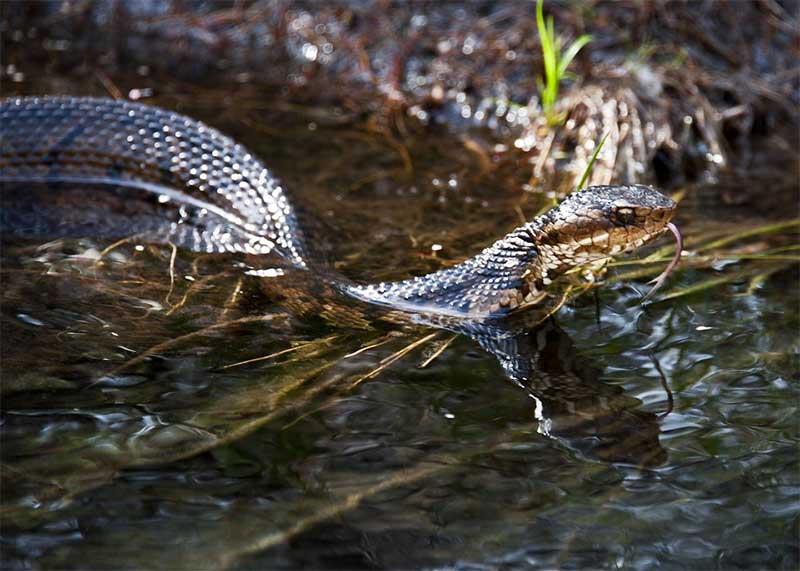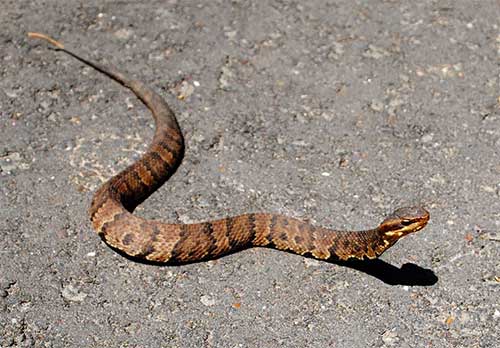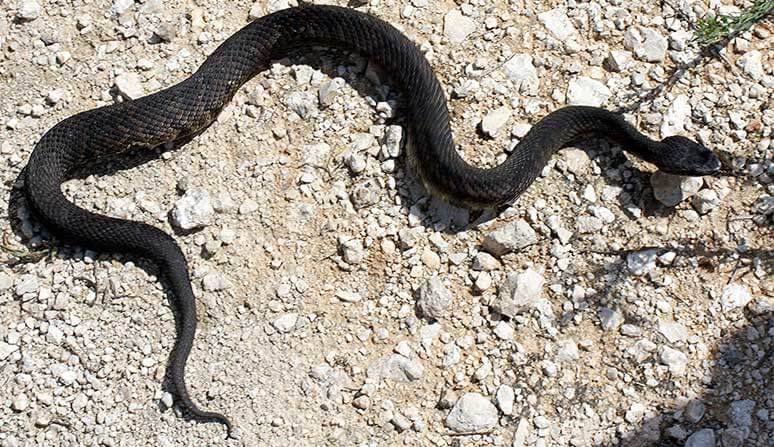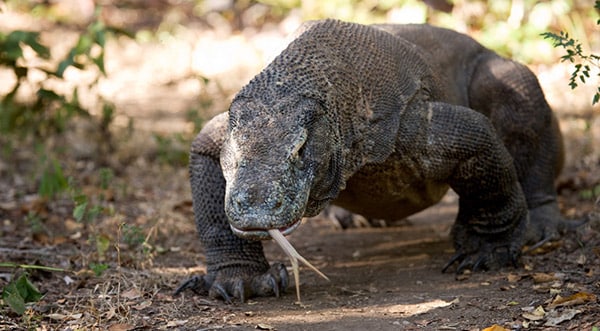There are many people out there that erroneously assume every swimming or water snake is a water moccasin.
Nothing could actually be further from the truth.
In fact, most snakes can technically swim, even those you might not think could like the diamond head rattlesnake.
And in the places where water moccasins actually live and thrive—the southeastern United States and some places along the southern Atlantic coast—there are literally hundreds of species of water-going snakes occupying the many marshes, ponds, rivers, lakes and streams.
Moreover, most of the bites from these non-water-moccasin snakes are completely harmless, which cannot be said of that of the water moccasin.
Truth be told, although water moccasins have venom that can be very harmful, they are not really an aggressive snake going after every species that moves.
In fact, one of their main goals is to avoid humans, and they would only strike when stepped on accidentally or when they felt truly threatened.
So just how do you identify a water moccasin.
Well, apart from what they actually look like in nature, to adequately answer that question you would need to know where they are typically found geographically, their habits, life cycle, what they eat and some of their identifying features.
To help you better identify a water moccasin should you come upon one, below we will briefly cover some of the above-mentioned traits.
Classifying the Water Moccasin
There are essentially three types of water moccasins, and all of them contain venom that could potentially harm or even kill (rarely) a human should the snake bite.
These three types include:
- the eastern water moccasin
- the western water moccasin
- the Florida water moccasin.
Most water moccasins are found in the southeastern part of the United States and they almost always live and hunt around water.
If you think you have come across a water moccasin, the best thing to do is to either stay still or slowly back away.
Normally, it will only strike if it feels threatened in some way.
If you come face to face with a water moccasin that is feeling threatened, you can recognize this threatened behavior by the way they coil their thick bodies, vibrate their tails, and open their mouths up wide to expose the cotton-like texture in the inside of their mouths, the texture that has earned these snakes their name to begin with.
The coiling of the body is done to give them an advantage, allowing them to strike further than they otherwise would if they were merely lying prostrate.
Although often confused as the snakes with the deadliest venom in the United States, this honor actually goes to the eastern rattlesnake.
Nobody knows exactly how many snake bites each year are attributed to water moccasins, but there are usually only 5 total snake bite fatalities per year on an average basis.

What Does a Water Moccasin Look Like?
Now to the question that is on the forefront of everybody’s mind: just what does a water moccasin look like—and how can you distinguish it from other water snakes?
Although there can be some exceptions, largely occurring from changes in environment or cross breeding, all three of the water moccasin varieties have very similar features.
Let’s take a brief look at some of these identifying features:
Juvenile Water Moccasin
The appearance of a juvenile water moccasin, which can be just as deadly as an adult, is much different than that of an adult.
Here are some things to look for on a juvenile water moccasin:
- Length. When it comes to length, the very young water moccasins are usually between 6 and 10 inches long.
- Coloring. A younger water moccasin is usually very bright in color, “with red bands that extend across its back and down its sides without crossing the belly.” These markings are set against a (mostly) brown body. Many of the markings on the juvenile water moccasin can contain dark flecks or spots.

Adult Water Moccasin
As we mentioned above, adult water moccasins can look very differently from their younger counterparts.
Here is just a short synopsis outlining the identifying markings on an adult water moccasin.
- Length. With regard to length, the adult water moccasin ranges widely in size, with the average measuring between 8 inches and 48 inches long. Thus far, the longest water moccasin ever identified and photographed was 74.5 inches long.
- Coloring. As the water moccasin gets on in age, the colorful bands around its body begin to fade, nearly to the point where they are not noticeable at all. Instead, most water moccasins have an all-brown or even black exterior.
- Girth. The water moccasin has a thick and heavy body, but that body narrows significantly at the neck area. Also, it gets slender more towards the tip of its tail as well.
- Scales. The water moccasin has “keeled” scales covering its body. These scales possess raised ridges that run lengthwise in the center. Due to their keeled and ridged scales, water moccasins do not appear shiny on the exterior as other snakes do in the water. Instead, they have a very dull and blah color that has no reflective surface.
- Head. The head of the water moccasin is noticeably bigger than the neck, which is one of the best ways to identify them. Some water moccasins will have a stripe across their eyes horizontally, but others do not possess this feature. When looking at a water moccasin from above, you cannot see its eyes. That’s because it has large plate-like scales that cover the top of its head. The water moccasin also has a deep facial pit that it uses to sense its prey’s body heat. The head has a wedge-like, flat and almost triangular appearance—an identifying feature that is common in all poisonous snakes. The widest portion of the head is adjacent to the mouth, where the snake does all of its damage.

Water moccasins will definitely hunt their prey while swimming underwater.
However, when not hunting, the water moccasin will either lay flat on the water or hang out near the water’s edge waiting for unsuspecting prey.
Other non-lethal water snakes merely bring their head out of the water, while leaving their bodies fully submerged underneath, and rarely come out of the water for any reason.
If you think you have spotted a water moccasin, NEVER approach it.
Although the snakes are not known for being very aggressive, they will bite if they feel threatened, and that bite can do a lot of damage if it is not rapidly treated.



